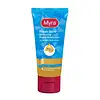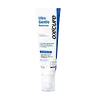What's inside
What's inside
 Key Ingredients
Key Ingredients

 Benefits
Benefits

 Concerns
Concerns

 Ingredients Side-by-side
Ingredients Side-by-side

Water
Skin ConditioningC12-15 Alkyl Benzoate
AntimicrobialCetyl Palmitate
EmollientCetyl Alcohol
EmollientSteareth-21
CleansingCyclopentasiloxane
EmollientNiacinamide
SmoothingGlycerin
HumectantEthylhexyl Methoxycinnamate
UV AbsorberTitanium Dioxide
Cosmetic ColorantPhenoxyethanol
PreservativeCI 16035
Cosmetic ColorantDimethicone
EmollientAcrylates/C10-30 Alkyl Acrylate Crosspolymer
Emulsion StabilisingDimethicone/Vinyl Dimethicone Crosspolymer
Skin ConditioningParfum
MaskingEthylhexylglycerin
Skin ConditioningDisodium EDTA
Sodium Hydroxide
BufferingSodium Starch Octenylsuccinate
AbsorbentCalcium Pantothenate
Maltodextrin
AbsorbentSodium Ascorbyl Phosphate
AntioxidantTocopheryl Acetate
AntioxidantPyridoxine Hcl
Skin ConditioningRumex Occidentalis Extract
Skin ConditioningAscorbic Acid
AntioxidantSilica
AbrasiveWater, C12-15 Alkyl Benzoate, Cetyl Palmitate, Cetyl Alcohol, Steareth-21, Cyclopentasiloxane, Niacinamide, Glycerin, Ethylhexyl Methoxycinnamate, Titanium Dioxide, Phenoxyethanol, CI 16035, Dimethicone, Acrylates/C10-30 Alkyl Acrylate Crosspolymer, Dimethicone/Vinyl Dimethicone Crosspolymer, Parfum, Ethylhexylglycerin, Disodium EDTA, Sodium Hydroxide, Sodium Starch Octenylsuccinate, Calcium Pantothenate, Maltodextrin, Sodium Ascorbyl Phosphate, Tocopheryl Acetate, Pyridoxine Hcl, Rumex Occidentalis Extract, Ascorbic Acid, Silica
Water
Skin ConditioningGlycerin
HumectantIsononyl Isononanoate
EmollientCetearyl Alcohol
EmollientC15-19 Alkane
SolventAmmonium Acryloyldimethyltaurate/Vp Copolymer
Hydrogenated Polydecene
EmollientPropanediol
SolventGlyceryl Stearate
EmollientPhenoxyethanol
PreservativePEG-100 Stearate
Squalane
EmollientCeteth-10 Phosphate
CleansingDicetyl Phosphate
EmulsifyingChlorphenesin
AntimicrobialPhytosteryl/Octyldodecyl Lauroyl Glutamate
Skin ConditioningXanthan Gum
EmulsifyingDisodium EDTA
Panthenol
Skin ConditioningAlpha-Glucan Oligosaccharide
CleansingPotassium Hydroxide
BufferingMaltodextrin
AbsorbentPolymnia Sonchifolia Root Juice
Skin ConditioningCeteareth-25
CleansingPropylene Glycol
HumectantAloe Barbadensis Leaf Extract
EmollientCetyl Alcohol
EmollientBHT
AntioxidantLactobacillus
Skin ConditioningPantolactone
HumectantBehenic Acid
CleansingCeramide NP
Skin ConditioningCholesterol
EmollientCeramide Ns
Skin ConditioningEthylhexylglycerin
Skin ConditioningTerminalia Ferdinandiana Fruit Extract
AntioxidantCeramide AP
Skin ConditioningCeramide EOP
Skin ConditioningCeramide Eos
Skin ConditioningCaprooyl Phytosphingosine
Skin ConditioningCaprooyl Sphingosine
Skin ConditioningAscorbyl Palmitate
AntioxidantCitric Acid
BufferingGlyceryl Oleate
EmollientLecithin
EmollientTocopherol
AntioxidantAnthemis Nobilis Flower Extract
MaskingCalendula Officinalis Flower Extract
MaskingCentaurea Cyanus Flower Extract
AstringentChamomilla Recutita Flower Extract
MaskingHypericum Perforatum Flower/Leaf/Stem Extract
Skin ConditioningTilia Cordata Flower Extract
Skin ConditioningWater, Glycerin, Isononyl Isononanoate, Cetearyl Alcohol, C15-19 Alkane, Ammonium Acryloyldimethyltaurate/Vp Copolymer, Hydrogenated Polydecene, Propanediol, Glyceryl Stearate, Phenoxyethanol, PEG-100 Stearate, Squalane, Ceteth-10 Phosphate, Dicetyl Phosphate, Chlorphenesin, Phytosteryl/Octyldodecyl Lauroyl Glutamate, Xanthan Gum, Disodium EDTA, Panthenol, Alpha-Glucan Oligosaccharide, Potassium Hydroxide, Maltodextrin, Polymnia Sonchifolia Root Juice, Ceteareth-25, Propylene Glycol, Aloe Barbadensis Leaf Extract, Cetyl Alcohol, BHT, Lactobacillus, Pantolactone, Behenic Acid, Ceramide NP, Cholesterol, Ceramide Ns, Ethylhexylglycerin, Terminalia Ferdinandiana Fruit Extract, Ceramide AP, Ceramide EOP, Ceramide Eos, Caprooyl Phytosphingosine, Caprooyl Sphingosine, Ascorbyl Palmitate, Citric Acid, Glyceryl Oleate, Lecithin, Tocopherol, Anthemis Nobilis Flower Extract, Calendula Officinalis Flower Extract, Centaurea Cyanus Flower Extract, Chamomilla Recutita Flower Extract, Hypericum Perforatum Flower/Leaf/Stem Extract, Tilia Cordata Flower Extract
 Reviews
Reviews

Ingredients Explained
These ingredients are found in both products.
Ingredients higher up in an ingredient list are typically present in a larger amount.
Cetyl Alcohol is a fatty alcohol. Fatty Alcohols are most often used as an emollient or to thicken a product.
Its main roles are:
Though it has "alcohol" in the name, it is not related to denatured alcohol or ethyl alcohol.
The FDA allows products labeled "alcohol-free" to have fatty alcohols.
Learn more about Cetyl AlcoholDisodium EDTA plays a role in making products more stable by aiding other preservatives.
It is a chelating agent, meaning it neutralizes metal ions that may be found in a product.
Disodium EDTA is a salt of edetic acid and is found to be safe in cosmetic ingredients.
Learn more about Disodium EDTAEthylhexylglycerin (we can't pronounce this either) is commonly used as a preservative and skin softener. It is derived from glyceryl.
You might see Ethylhexylglycerin often paired with other preservatives such as phenoxyethanol. Ethylhexylglycerin has been found to increase the effectiveness of these other preservatives.
Glycerin is already naturally found in your skin. It helps moisturize and protect your skin.
A study from 2016 found glycerin to be more effective as a humectant than AHAs and hyaluronic acid.
As a humectant, it helps the skin stay hydrated by pulling moisture to your skin. The low molecular weight of glycerin allows it to pull moisture into the deeper layers of your skin.
Hydrated skin improves your skin barrier; Your skin barrier helps protect against irritants and bacteria.
Glycerin has also been found to have antimicrobial and antiviral properties. Due to these properties, glycerin is often used in wound and burn treatments.
In cosmetics, glycerin is usually derived from plants such as soybean or palm. However, it can also be sourced from animals, such as tallow or animal fat.
This ingredient is organic, colorless, odorless, and non-toxic.
Glycerin is the name for this ingredient in American English. British English uses Glycerol/Glycerine.
Learn more about GlycerinMaltodextrin is a polysaccharide. It is derived from starch such as rice, corn, wheat, or potato starch.
In food, Maltodextrin is used to improve the texture and thicken a product. Due to its structure, it can help create a gel texture. As an emulsion stabilizer, it helps keep the ingredients in a product together.
As a polysaccharide, Maltodextrin has moisturizing properties. Polysaccharides are a type of carbohydrate. The top layer of skin uses polysaccharides to retain water, keeping the skin hydrated.
Maltodextrin is water soluble and has a sweet taste.
Learn more about MaltodextrinPhenoxyethanol is a preservative that has germicide, antimicrobial, and aromatic properties. Studies show that phenoxyethanol can prevent microbial growth. By itself, it has a scent that is similar to that of a rose.
It's often used in formulations along with Caprylyl Glycol to preserve the shelf life of products.
Water. It's the most common cosmetic ingredient of all. You'll usually see it at the top of ingredient lists, meaning that it makes up the largest part of the product.
So why is it so popular? Water most often acts as a solvent - this means that it helps dissolve other ingredients into the formulation.
You'll also recognize water as that liquid we all need to stay alive. If you see this, drink a glass of water. Stay hydrated!
Learn more about Water